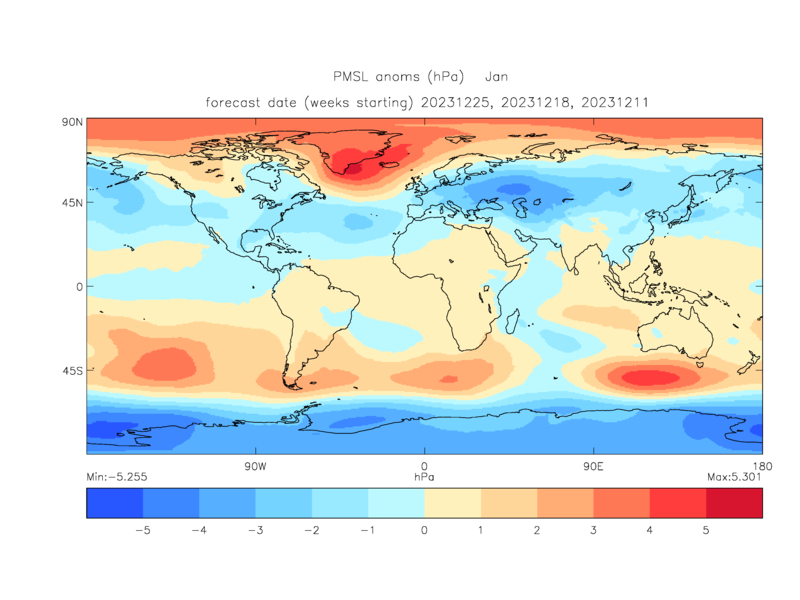Will the current cold spell last or will we see a return to the wet and windy weather we experienced through the Christmas and new year period?
After the unsettled Christmas and New Year period we are now seeing an abrupt change to much colder weather with temperatures below average for January for much of the UK and an increasing chance of cold weather impacts. Frost is likely overnight and, given the ground moisture, calm conditions, and long nights, there is also a risk of fog and icy conditions.
As always, there is a great deal of speculation about how long the cold spell might last and how cold it might get. To answer these questions, we need to look beyond the UK. When looking at forecasts beyond five days into the future, global weather can have significant impacts on the UK weather and can drive persistent weather patterns here.
World weather is interconnected, and longer-range forecasts rely on slowly varying aspects of the global weather and climate system, known as climate drivers. There are large scale global drivers which we know have influences on UK weather at this time of year – so what are these doing at the moment?
A strong El Niño, the naturally occurring warming of the Pacific Ocean, is now fully developed. This increases the likelihood that the second half of winter and early spring will be colder and drier than the first half.
There is also a Sudden Stratospheric Warming (SSW) underway, but this is currently a minor event as the stratospheric winds are only expected to weaken and are not expected to fully reverse. Even so, this could still impact weather at the earth’s surface as the Stratospheric Polar Vortex is very weak compared to its usual strong westerly state and it is also still possible that a major SSW could occur later this winter.
A SSW can result in a ‘blocked’ weather pattern for the UK, leading to a reduction in Atlantic low pressure systems crossing the UK and therefore, increasing the chance of cold, dry weather here and mild, wet and windy conditions for southern Europe. However, the impacts of an SSW on UK weather can also be benign, it does not always lead to cold weather.
Professor Adam Scaife, Head of Long-Range Forecasting at the Met Office, said: “The current weakening of the stratospheric polar vortex tallies with our forecasts for more blocked, colder and drier conditions in the coming month.”
Another factor influencing the UK this winter is the Quasi-Biennial Oscillation (QBO), a regular variation of the winds that blow high above the equator. The QBO is currently in an easterly phase, increasing the likelihood of cold northerly or easterly winds from the Arctic and continental Europe.
Meanwhile the North Atlantic Oscillation, variations in the large-scale surface pressure gradient in the North Atlantic region, is moving into a negative phase. This reduces the risk of storms and also increases the risk of colder weather. The current pattern of sea surface temperatures in the North Atlantic Ocean is yet another driver which, at this time, is conducive to a reduction in the chance of storm bearing westerly winds.

This is a pressure forecast map. It shows the higher than normal pressure to the north and west of the UK on average. This indicates increased chances of cold north-easterly winds during the coming month.
All these effects are happening on a background of warming UK winters, consistent with wider global warming trends.
Therefore, taking all these ‘global drivers’ into consideration, our long-range forecast systems suggest that there is an increased chance of colder than average conditions compared to normal as we head through the rest of this winter with an increasing risk of cold weather impacts such as snow and ice.
It is important to remember that the science of longer-range and seasonal outlooks is at the cutting edge of meteorology and comes with inherent uncertainties. While the Met Office is one of the leaders in scientific research in the area, even with ‘perfect’ prediction systems and ‘perfect’ meteorological observations, the fundamental chaotic nature of the atmosphere will still limit the skill of these predictions.
Despite any speculation you may read elsewhere the science at this time simply does not allow for specific detail on the amount of rain or snow over the coming months or exactly when severe weather may occur. However, long-range forecasts can provide useful information on the likelihood of possible conditions averaged over the UK for the season as a whole.
You can check the long range forecast and daily weather forecast on our website. You can also follow us on Twitter and Facebook, as well as on our mobile app which is available for iPhone from the App store and for Android from the Google Play store. Our three-month outlooks are updated each month. Keep track of current weather warnings on the weather warning page.


